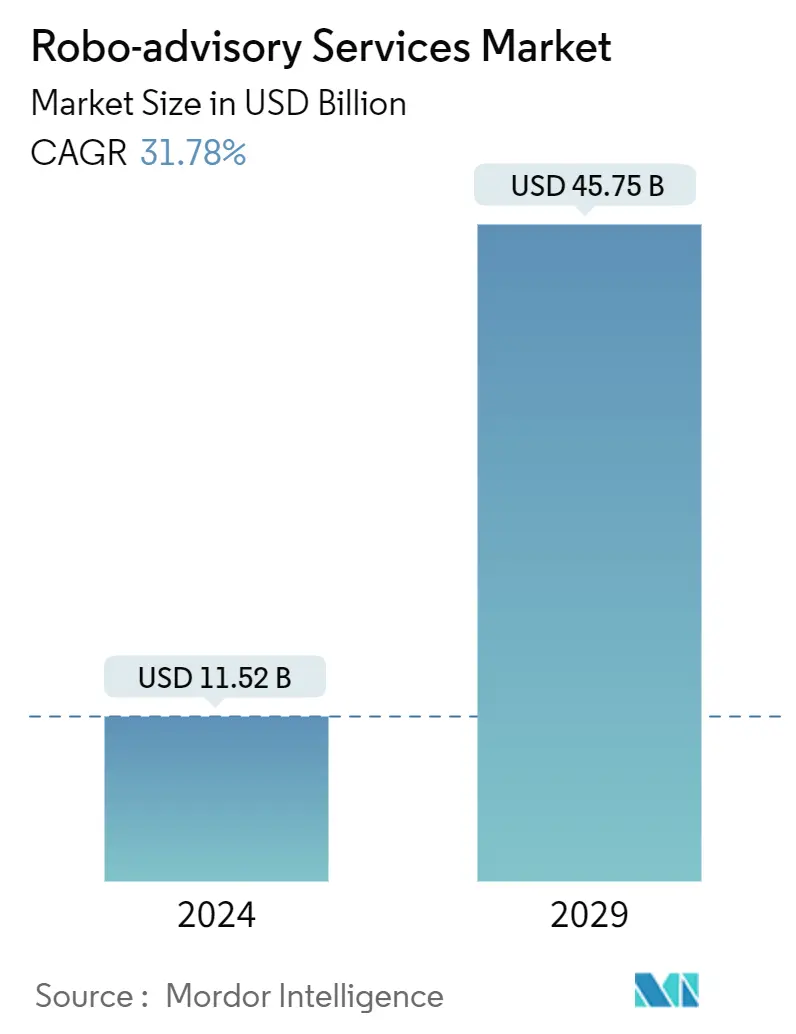Market Size of Robo-advisory Services Industry

| Study Period | 2019 - 2029 |
| Market Size (2024) | USD 11.52 Billion |
| Market Size (2029) | USD 45.75 Billion |
| CAGR (2024 - 2029) | 31.78 % |
| Fastest Growing Market | Asia Pacific |
| Largest Market | North America |
Major Players
*Disclaimer: Major Players sorted in no particular order |
Need a report that reflects how COVID-19 has impacted this market and its growth?
Robo Advisory Services Market Analysis
The Robo-advisory Services Market size is estimated at USD 11.52 billion in 2024, and is expected to reach USD 45.75 billion by 2029, growing at a CAGR of 31.78% during the forecast period (2024-2029).
The rapid digitization of the BFSI industry has accelerated the growth of digital investments in which Robo-advisors play a major role. The Robo-advisory services are beneficial majorly for passive investors who do not prefer personal monitoring of their portfolio development.
- Rapid automation of processes and businesses across end-user industries is acting as a major catalyst for the adoption of Robo-advisory services. These services eliminate human labor, as the online platforms offer the same services at a fraction of the cost. Also, the services are available 24/7 as long as the user has an Internet connection.
- Several emerging economies are stimulating the regional players to enhance their testing and research of Robo-advisory services. These initiatives are further expected to act as a catalyst for market growth. For instance, Saudi Arabia's Capital Market Authority (CMA) approved Wahed Capital and Haseed Investing Company to test its Robo-advisory services. This was done as part of the country's strategy to encourage the use of financial technology in the Arab economy.
- Amidst the coronavirus outbreak, lockdown, and market uncertainty, a surge in B2B Robo-advisors, Digital investing, financial advice, and portfolio management is witnessed globally. A rapid shift from traditional investment services to robo-advisory investment services is another factor in market growth. In addition, investment platforms are now offering robo-advisors as new digital financial advisors over traditional investment services, enabling the scope of expansion for robo-advisors.
- The widespread use of robo-advisory throughout industrial verticals such as retail banking, asset management, and others for conducting algorithmic calculations to analyze data and transmit comprehensive information driving the market forward. Moreover, robo advisors offer specific benefits such as tax-loss harvesting, low-cost portfolio, better decision-making, safe and secure investments, and help eliminate credit risks. Such factors are anticipated to drive industry growth over the forecast period.
- However, the limited flexibility offered by robo advisors is anticipated to restrain the market's growth during the forecast period. In addition, the lack of face-to-face meetings leading to consultation barriers between investors and advisors is also expected to hinder market growth. However, the demand for low-cost investment advisory is anticipated to open up opportunities for market growth. Furthermore, the growing usage of advanced analytics and big data can potentially broaden the scope of robo-advisors significantly.
Robo Advisory Services Industry Segmentation
Robo-advisory services are digital, including automated, algorithm-driven financial planning services with little human supervision. A Robo-advisor collects financial information from the clients, such as their current financial situation and future financial goals, through an online survey. The Robo-advisor then aggregates the collected data and uses it to offer advice and automatically invest client assets. The robo-advisory services provide easy account setup, robust goal planning, account services, portfolio management, security features, and continuous customer service at low fees.
The robo-advisory services market is segmented by type of services (investment advisor, wealth management, retirement planning, and tax-loss harvesting) and geography (North America, Europe, Asia-Pacific). The market size and forecasts are provided in terms of value (USD) for all the above segments.
| By Type of Services | |
| Investment Advisors | |
| Wealth Management | |
| Retirement Planning | |
| Tax-loss Harvesting |
| By Geography | |
| North America | |
| Europe | |
| Asia-Pacific | |
| Rest of the World |
Robo-advisory Services Market Size Summary
The Robo-advisory Services Market is projected to experience significant growth in the coming years. This growth is largely driven by rapid digitization in the BFSI industry, which has increased the role of robo-advisors in digital investments. These services are particularly beneficial for passive investors who do not prefer personal monitoring of their portfolio development. Additionally, the automation of processes and businesses across various industries is acting as a major catalyst for the adoption of robo-advisory services. These services are available 24/7 and eliminate human labor, offering the same services at a fraction of the cost. The market is also being propelled by initiatives in emerging economies to enhance testing and research of robo-advisory services. Despite the anticipated growth, some factors could potentially hinder the market's progress. One such factor is the limited flexibility offered by robo advisors. Additionally, the lack of face-to-face meetings could lead to consultation barriers between investors and advisors. However, the demand for low-cost investment advisory is expected to open up opportunities for market growth. Furthermore, the growing usage of advanced analytics and big data can potentially broaden the scope of robo-advisors significantly. The industry is also expected to benefit from the increased adoption of technology-enabled analytics for investment consultations in the financial sector.
Explore MoreRobo-advisory Services Market Size - Table of Contents
-
1. MARKET DYNAMICS
-
1.1 Market Drivers
-
1.1.1 Digitization of the BFSI Industry
-
1.1.2 Cost-efficiency in Managing Personal Finance
-
-
1.2 Market Restraints
-
1.2.1 Lack of Human Expertise and Empathy
-
1.2.2 Nascency of the Technology
-
-
-
2. MARKET SEGMENTATION
-
2.1 By Type of Services
-
2.1.1 Investment Advisors
-
2.1.2 Wealth Management
-
2.1.3 Retirement Planning
-
2.1.4 Tax-loss Harvesting
-
-
2.2 By Geography
-
2.2.1 North America
-
2.2.2 Europe
-
2.2.3 Asia-Pacific
-
2.2.4 Rest of the World
-
-
Robo-advisory Services Market Size FAQs
How big is the Robo-advisory Services Market?
The Robo-advisory Services Market size is expected to reach USD 11.52 billion in 2024 and grow at a CAGR of 31.78% to reach USD 45.75 billion by 2029.
What is the current Robo-advisory Services Market size?
In 2024, the Robo-advisory Services Market size is expected to reach USD 11.52 billion.
